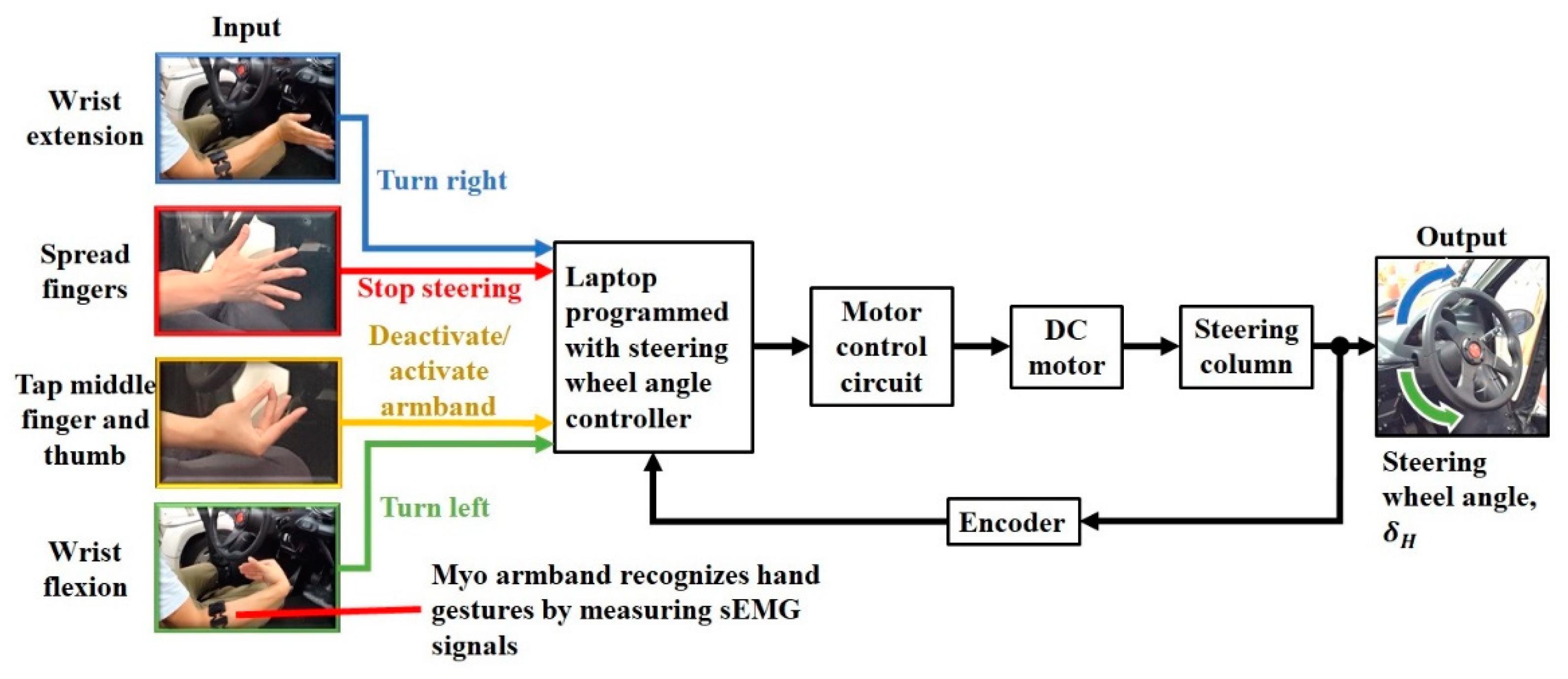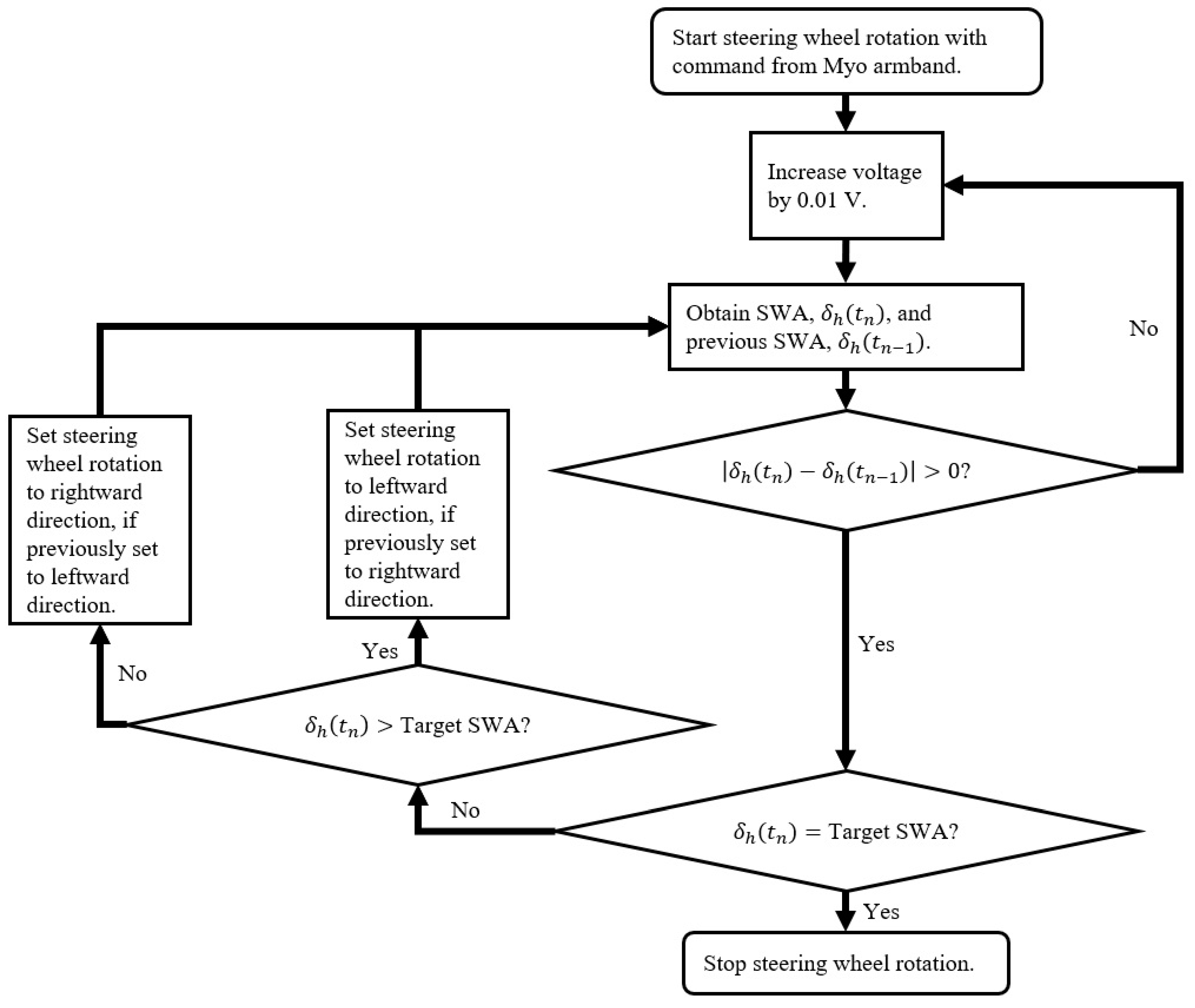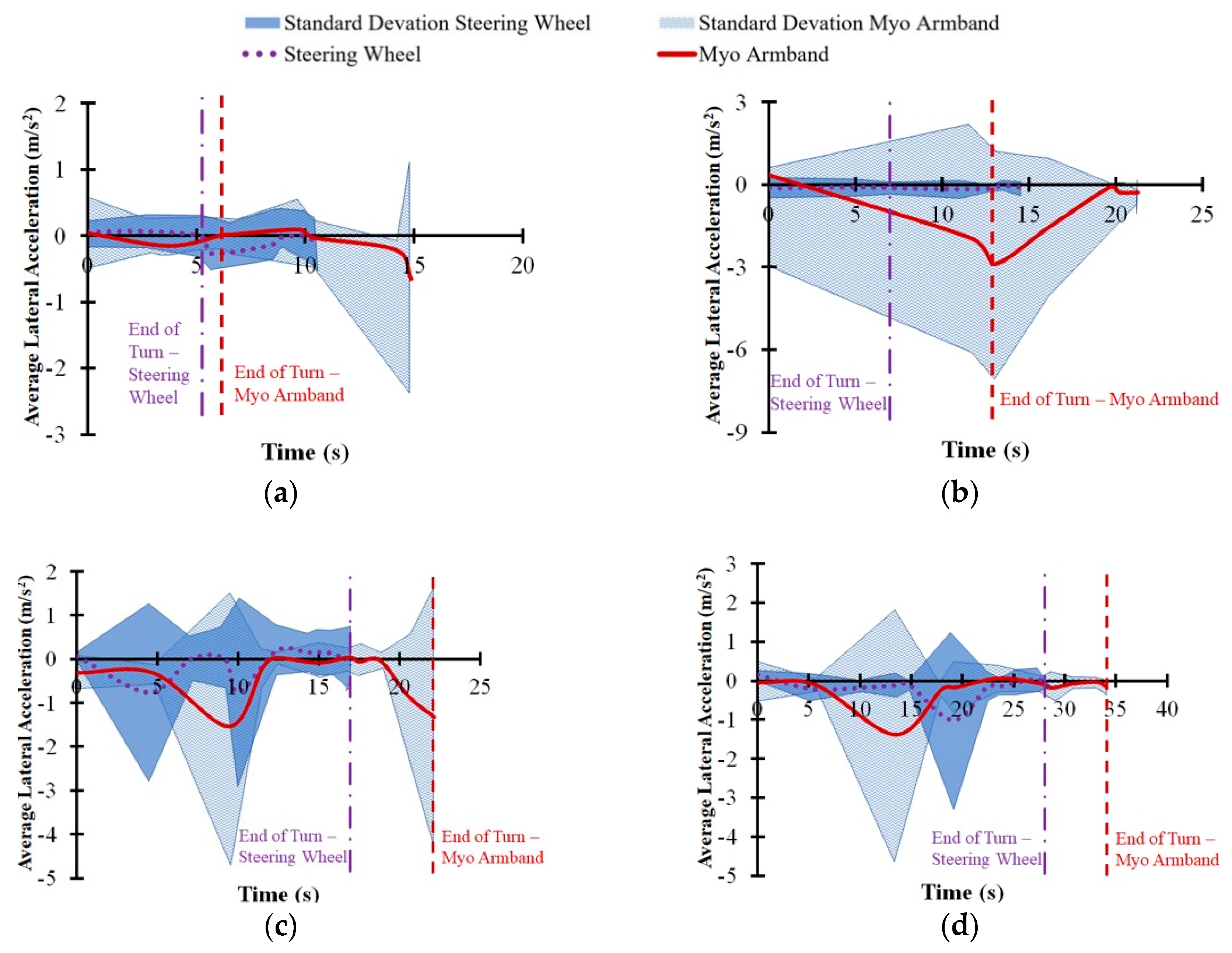Surface Electromyography-Controlled Automobile Steering Assistance
Abstract
:1. Introduction
2. Materials and Methods
2.1. Steering Assistance Interface
2.1.1. Position Tracking Equipment for Test Vehicle
2.2. Methodology
3. Results
- higher maximum and average SWR
- lower average vehicle speed
4. Discussion
4.1. Relationship Between Path-Following Accuracy and Vehicle Motion
4.2. Limitations
5. Conclusions
Author Contributions
Acknowledgments
Conflicts of Interest
References
- Verrall, T.; Kulkarni, J.R. Driving appliances for upper limb amputees. Prosthet. Orthot. Int. 1995, 19, 124–127. [Google Scholar] [CrossRef] [Green Version]
- Jung, N.; Kim, H.; Chang, M. Muscle activation of drivers with hemiplegia caused by stroke while driving using a steering wheel or knob. J. Phys. Ther. Sci. 2015, 27, 1009–1011. [Google Scholar] [CrossRef] [PubMed] [Green Version]
- Minato, T.; Murata, Y.; Suzuki, A. Proposal of Automobile Driving Interface Using Strain Sensor for the Disabled People. In Proceedings of the 2015 Tohoku-Section Joint Convention of Institutes of Electrical and Information Engineers, Takizawa, Japan, 6 September 2015. [Google Scholar]
- Kukkala, V.K.; Tunnell, J.; Pasricha, S.; Bradley, T. Advanced Driver-Assistance Systems: A Path Toward Autonomous Vehicles. IEEE Consum. Electron. Mag. 2018, 7, 18–25. [Google Scholar] [CrossRef]
- Sucu, B.; Folmer, E. The Blind Driver Challenge: Steering Using Haptic Cues. In Proceedings of the 16th International ACM SIGACCESS Conference on Computers & Accessibility, New York, NY, USA, 20–22 October 2014; pp. 3–10. [Google Scholar]
- Umeno, R.; Itoh, M.; Kitazaki, S. Influence of automated driving on driver’s own localization: a driving simulator study. J. Intell. Connect. Veh. 2018, 1, 99–106. [Google Scholar] [CrossRef] [Green Version]
- Muslim, H.; Itoh, M. A theoretical framework for designing human-centered automotive automation systems. Cogn. Technol. Work 2018. [Google Scholar] [CrossRef]
- Manawadu, U.E.; Hayashi, H.; Ema, T.; Kawano, T.; Kamezaki, M.; Sugano, S. Tactical-Level Input with Multimodal Feedback for Unscheduled Takeover Situations in Human-Centered Automated Vehicles. In Proceedings of the 2018 IEEE/ASME International Conference on Advanced Intelligent Mechatronics (AIM), Auckland, New Zealand, 9–12 July 2018; pp. 634–639. [Google Scholar]
- Murata, Y.; Yoshida, K. Automobile Driving Interface Using Gesture Operations for Disabled People. Int. J. Adv. Intell. Syst. 2012, 6, 329–341. [Google Scholar]
- Wada, M.; Kimura, Y. Stability analysis of car driving with a joystick interface. In Proceedings of the 2013 IEEE 4th International Conference on Cognitive Infocommunications (CogInfoCom), Budapest, Hungary, 2–5 December 2013; pp. 493–496. [Google Scholar]
- Kar, A.; Corcoran, P. A review and analysis of eye-gaze estimation systems, algorithms and performance evaluation methods in consumer platforms. IEEE Access 2017, 5, 16495–16519. [Google Scholar] [CrossRef]
- Minguillon, J.; Lopez-Gordo, M.A.; Pelayo, F. Trends in EEG-BCI for daily-life: Requirements for artifact removal. Biomed. Signal Process. Control 2017, 31, 407–418. [Google Scholar] [CrossRef]
- Lotte, F.; Larrue, F.; Mühl, C. Flaws in current human training protocols for spontaneous Brain-Computer Interfaces: lessons learned from instructional design. Front. Hum. Neurosci. 2013, 7, 9–19. [Google Scholar] [CrossRef] [Green Version]
- Iqbal, N.V.; Subramaniam, K. A Review on Upper-Limb Myoelectric Prosthetic Control. IETE J. Res. 2018, 64, 740–752. [Google Scholar] [CrossRef]
- Hudgins, B.; Parker, P.; Scott, R.N. A new strategy for multifunction myoelectric control. IEEE Trans. Biomed. Eng. 1993, 40, 82–94. [Google Scholar] [CrossRef]
- Alsnih, R.; Hensher, D.A. The mobility and accessibility expectations of seniors in an aging population. Transp. Res. Part A Policy Pract. 2003, 37, 903–916. [Google Scholar] [CrossRef]
- Kwak, J.; Jeon, T.W.; Park, H.; Kim, S.; An, K. Development of an EMG-Based Car Interface Using Artificial Neural Networks for the Physically Handicapped. Korea IT Serv. J. 2008, 7, 149–164. [Google Scholar]
- Nacpil, E.J.; Zheng, R.; Kaizuka, T.; Nakano, K. Implementation of a sEMG-machine interface for steering a virtual car in a driving simulator. In Proceedings of the AHFE 2017 International Conference on Human Factors in Simulation and Modeling, Los Angeles, CA, USA, 17–21 July 2018; pp. 274–282. [Google Scholar]
- Gomez-Gil, J.; San-Jose-Gonzalez, I.; Nicolas-Alonso, L.F.; Alonso-Garcia, S. Steering a tractor by means of an EMG-based human-machine interface. Sensors 2011, 11, 7110–7126. [Google Scholar] [CrossRef] [PubMed] [Green Version]
- De Freitas, R.C.; Alves, R.; da Silva Filho, A.G.; de Souza, R.E.; Bezerra, B.L.D.; dos Santos, W.P. Electromyography-controlled car: A proof of concept based on surface electromyography, Extreme Learning Machines and low-cost open hardware. Comput. Electr. Eng. 2019, 73, 167–179. [Google Scholar] [CrossRef]
- Liu, Y.; Liu, Q.; Lv, C.; Zheng, M.; Ji, X. A study on objective evaluation of vehicle steering comfort based on driver’s electromyogram and movement trajectory. IEEE Trans. Human-Machine Syst. 2018, 48, 41–49. [Google Scholar] [CrossRef]
- Liu, Y.; Ji, X.; Hayama, R.; Mizuno, T.; Nakano, S. Method for measuring a driver’s steering efficiency using electromyography. Proc. Inst. Mech. Eng. Part D J. Automob. Eng. 2014, 228, 1170–1184. [Google Scholar] [CrossRef]
- Yabuki, Y.; Tanahashi, K.; Hoshikawa, S.; Nakamura, T.; Kato, R.; Jiang, Y.; Yokoi, H. Development of New Cosmetic Gloves for Myoelectric Prosthetic Hand by Using Thermoplastic Styrene Elastomer. In Intelligent Autonomous Systems 14; Chen, W., Hosoda, K., Menegatti, E., Shimizu, M., Wang, H., Eds.; Springer International Publishing: Cham, Switzerland, 2017; pp. 269–282. [Google Scholar]
- Hakonen, M.; Piitulainen, H.; Visala, A. Current state of digital signal processing in myoelectric interfaces and related applications. Biomed. Signal Process. Control 2015, 18, 334–359. [Google Scholar] [CrossRef] [Green Version]
- Nacpil, E.J.C.; Wang, Z.; Zheng, R.; Kaizuka, T.; Nakano, K. Design and Evaluation of a Surface Electromyography-Controlled Steering Assistance Interface. Sensors 2019, 19. [Google Scholar] [CrossRef] [Green Version]
- Nacpil, E.J.C.; Zheng, R.; Kaizuka, T.; Nakano, K. A surface electromyography controlled steering assistance interface. J. Intell. Connect. Veh. 2019, 2, 1–13. [Google Scholar] [CrossRef] [Green Version]
- Abayasiri, R.A.M.; Madusanka, D.G.K.; Arachchige, N.M.P.; Silva, A.T.S.; Gopura, R.A.R.C. MoBio: A 5 DOF trans-humeral robotic prosthesis. In Proceedings of the 2017 International Conference on Rehabilitation Robotics (ICORR), London, UK, 17–20 July 2017; pp. 1627–1632. [Google Scholar]
- APL’s Modular Prosthetic Limb Reaches New Levels of Operability. Available online: https://www.jhuapl.edu/PressRelease/160112 (accessed on 6 January 2020).
- Johannes, M.S.; Bigelow, J.D.; Burck, J.M.; Harshbarger, S.D.; Kozlowski, M.V.; Van Doren, T. An overview of the developmental process for the modular prosthetic limb. Johns Hopkins APL Tech. Dig. 2011, 30, 207–216. [Google Scholar]
- De Winter, J.C.F.; Happee, R. Advantages and Disadvantages of Driving Simulators: A Discussion. In Proceedings of the Measuring Behavior; Noldus Information Technology B.V: Utrecht, The Netherlands; pp. 47–50.
- Ishak, M.I.; Ogino, H.; Oshinoya, Y. Introduction on dynamic motion of opposite and parallel steering for electric vehicle. In Proceedings of the 2013 IEEE Conference on Systems, Process & Control (ICSPC), Kuala Lumpur, Malaysia, 13–15 December 2013; pp. 73–708. [Google Scholar]
- Ishak, M.I.; Ogino, H.; Yamamoto, Y. Numerical Simulation Analysis of an Oversteer In-Wheel Small Electric Vehicle Integrated with Four-Wheel Drive and Independent Steering. Int. J. Veh. Technol. 2016, 2016, 12. [Google Scholar] [CrossRef] [Green Version]
- Liu, X.; Uchino, D.; Ikeda, K.; Endo, A.; Peeie, M.H.; Narita, T.; Kato, H. Driving Assist System for Ultra-Compact EVs―Fundamental Consideration of Muscle Burden Owing to Differences in the Drivers’ Physiques. Actuators 2018, 7, 44. [Google Scholar] [CrossRef] [Green Version]
- COMS Catalog. Available online: http://coms.toyotabody.jp/download/pdf/coms_catalog.pdf (accessed on 1 April 2019).
- Ding, I.-J.; Lin, R.-Z.; Lin, Z.-Y. Service robot system with integration of wearable Myo armband for specialized hand gesture human–computer interfaces for people with disabilities with mobility problems. Comput. Electr. Eng. 2018, 69, 815–827. [Google Scholar] [CrossRef]
- Ur Rehman, M.; Waris, A.; Gilani, S.O.; Jochumsen, M.; Niazi, I.K.; Jamil, M.; Farina, D.; Kamavuako, E.N. Multiday EMG-Based Classification of Hand Motions with Deep Learning Techniques. Sensors 2018, 18, 2497. [Google Scholar] [CrossRef] [PubMed] [Green Version]
- Masson, S.; Fortuna, F.; Moura, F.; Soriano, D. Integrating Myo armband for the control of myoelectric upper limb prosthesis. In Proceedings of the XXV Congresso Brasileiro de Engenharia Biomédica–CBEB 2016, Rio de Janeiro, Brazil, 17–20 October 2016; pp. 17–20. [Google Scholar]
- Pizzolato, S.; Tagliapietra, L.; Cognolato, M.; Reggiani, M.; Müller, H.; Atzori, M. Comparison of six electromyography acquisition setups on hand movement classification tasks. PLoS ONE 2017, 12, 1–17. [Google Scholar] [CrossRef] [Green Version]
- Mendez, I.G.; Pálsdóttir, Á.A.; Eiriksdóttir, D.H.; Faulkner, M.; Sriranjan, N.; Waris, A.; Kamavuako, E.N. Evaluation of classifiers performance using the Myo armband. In Proceedings of the Conference Proceedings, Myoelectric Controls and Upper Limb Prosthetics Symposium, Fredericton, NB, Canada, 15–18 August 2017; p. 98. [Google Scholar]
- Passenger Cars—Steady-State Circular Driving Behaviour—Open-Loop Test Methods; ISO 4138:2012(E); International Standards Office: Geneva, Switzerland, 2012.
- Ma, B.; Yang, Y.; Liu, Y.; Ji, X.; Zheng, H. Analysis of vehicle static steering torque based on tire-road contact patch sliding model and variable transmission ratio. Adv. Mech. Eng. 2016, 8, 1–11. [Google Scholar] [CrossRef] [Green Version]
- Sharp, R.S.; Granger, R. On car steering torques at parking speeds. Proc. Inst. Mech. Eng. Part D J. Automob. Eng. 2003, 217, 87–96. [Google Scholar] [CrossRef]
- Manawadu, U.E.; Kamezaki, M.; Ishikawa, M.; Kawano, T.; Sugano, S. A multimodal human-machine interface enabling situation-Adaptive control inputs for highly automated vehicles. In Proceedings of the 2017 IEEE Intelligent Vehicles Symposium (IV), Los Angeles, CA, USA, 11–14 June 2017. [Google Scholar]
- Bladfält, S.L.; Grane, C.; Bengtsson, P. Gear Shifter Design – Lack of Dedicated Positions and the Contribution to Cognitive Load and Inattention BT. In Proceedings of the AHFE 2019 International Conference on Human Factors in Transportation, Washington, DC, USA, 24–28 July 2019; pp. 487–498. [Google Scholar]
- Yun, S.; Wen, W.; An, Q.; Hamasaki, S.; Yamakawa, H.; Tamura, Y.; Yamashita, A.; Asama, H. Investigating the Relationship Between Assisted Driver’s SoA and EEG. In Converging Clinical and Engineering Research on Neurorehabilitation III.; Masia, L., Micera, S., Akay, M., Pons, J.L., Eds.; Springer International Publishing: Cham, Switzerland, 2019; pp. 1039–1043. [Google Scholar]
- Wang, Z.; Zheng, R.; Kaizuka, T.; Nakano, K. Relationship Between Gaze Behavior and Steering Performance for Driver–Automation Shared Control: A Driving Simulator Study. IEEE Trans. Intell. Veh. 2019, 4, 154–166. [Google Scholar] [CrossRef]











| Interface | Driving Scenario | Average Steering Wheel Rate (°/s) | Standard Deviation of Steering Wheel Rate (°/s) | Maximum Steering Wheel Rate (°/s) |
|---|---|---|---|---|
| Steering wheel | 45° turn | 152.82 | 185.18 | 499.11 |
| 90° turn | 47.08 | 37.61 | 96.94 | |
| Narrow U-turn | 87.73 | 79.93 | 247.31 | |
| Wide U-turn | 18.32 | 9.44 | 34.04 | |
| Myo armband | 45° turn | 89.98 | 136.60 | 364.05 |
| 90° turn | 57.35 | 55.61 | 149.84 | |
| Narrow U-turn | 42.86 | 34.87 | 95.11 | |
| Wide U-turn | 20.13 | 13.80 | 44.62 |
© 2020 by the authors. Licensee MDPI, Basel, Switzerland. This article is an open access article distributed under the terms and conditions of the Creative Commons Attribution (CC BY) license (http://creativecommons.org/licenses/by/4.0/).
Share and Cite
Nacpil, E.J.C.; Nakano, K. Surface Electromyography-Controlled Automobile Steering Assistance. Sensors 2020, 20, 809. https://doi.org/10.3390/s20030809
Nacpil EJC, Nakano K. Surface Electromyography-Controlled Automobile Steering Assistance. Sensors. 2020; 20(3):809. https://doi.org/10.3390/s20030809
Chicago/Turabian StyleNacpil, Edric John Cruz, and Kimihiko Nakano. 2020. "Surface Electromyography-Controlled Automobile Steering Assistance" Sensors 20, no. 3: 809. https://doi.org/10.3390/s20030809
APA StyleNacpil, E. J. C., & Nakano, K. (2020). Surface Electromyography-Controlled Automobile Steering Assistance. Sensors, 20(3), 809. https://doi.org/10.3390/s20030809





